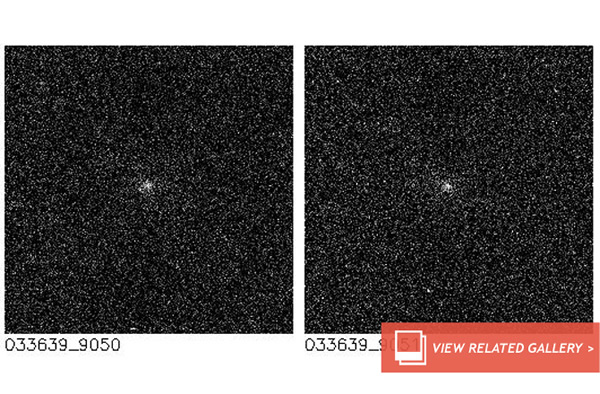Mars Orbiter Spies Lackluster Comet ISON
Mars Orbiter Spies Lackluster Comet ISON
Scientists managing the High-Resolution Imaging Science Experiment (HiRISE) camera aboard NASA’s Mars Reconnaissance Orbiter (MRO) have released their first observations of the incoming Comet ISON. The MRO was commanded to turn away its perpetual Mars-ward gaze and point into deep space to capture its own snapshot of the famous comet. ISON is currently making its closest approach to the red planet, passing just 7 million miles from its surface.
The first raw images were snapped on Sept. 29 when the object was 8 million miles from the planet and more images (taken on Oct. 1 and Oct. 2) are currently being processed. The four initial observations reveal a fuzzy cometary object moving relative to background stars. Detail is lacking as the comet is still too distant, but these observations are useful to gauge how the brightness of the object compares to predicted values. So far, ISON is at the “low end” of predicted brightness values.
“Based on preliminary analysis of the data, the comet appears to be at the low end of the range of brightness predictions for the observation,” writes Alan Delamere and Alfred McEwen in a University of Arizona news release. “As a result, the image isn’t visually pleasing but low coma activity is best for constraining the size of the nucleus.”
The comet is currently 150 million miles from the sun, but as it falls deeper and deeper into the sun’s gravitational well, ISON will likely brighten as icy volatiles from the comet’s nucleus heat up and erupt into space. The addition of gas and dust should cause the comet’s coma to increase in size.
But will this be the comet of the century? Many astronomers are becoming increasingly skeptical of that fact.
Comet ISON was discovered in Sept. 2012 and its orbit initially caused some excitement. The object appears to be a “virgin” comet from the hypothesized Oort Cloud that is thought to contain billions of icy objects that intermittently drop into the inner solar system as comets. The pristine nature of Comet ISON led many to believe that once heated by the sun’s heat, it could erupt, making this a historic event. Although notable, ISON appears to be holding its own and may not erupt into the “daytime” comet we were hoping for.
This “sungrazer” will come within 724,000 miles of the sun on Nov. 28, so it will be interesting to see whether the comet’s nucleus survives its fiery descent.
Image credit: NASA/JPL/University of Arizona(Oct 2, 2013 01:31 PM ET // by Ian O'Neill)












